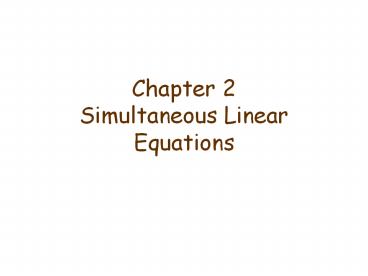Chapter 2 Simultaneous Linear Equations - PowerPoint PPT Presentation
Title:
Chapter 2 Simultaneous Linear Equations
Description:
Chapter 2 Simultaneous Linear Equations A system of m linear equations in n variables is a set of m equations, each of which is linear in the same n variables: A ... – PowerPoint PPT presentation
Number of Views:230
Avg rating:3.0/5.0
Title: Chapter 2 Simultaneous Linear Equations
1
Chapter 2Simultaneous Linear Equations
2
2.1 Linear systems
- A system of m linear equations in n variables is
a set of m equations, each of which is linear in
the same n variables - A solution is a set of scalars x1 , x2 , , xn
that when substituted in the system satisfies the
given equations. - A linear system can possess exactly one solution,
an infinite number of solutions, or no solution. - A linear system is called consistent if it has at
least one solution and inconsistent if it has no
solution. - A linear system can be written in matrix form Ax
b (see details on the board) - A linear system is called homogenous if b0
3
2.1 Linear systems (HW example) Modeling a
real-life situation as a linear model
- A manufacturer produces desks and bookcases.
- Desks d require 5 hours of cutting time and 10
hours of assembling time. - Bookcases b require 15 minutes of cutting time
and one hour of assembling time. - Each day, the manufacturer has available 200
hours for cutting and 500 hours for assembling. - The manufacturer wants to know how many desks and
bookcases should be scheduled for completion each
day to utilize all available workpower. - Show that this problem is equivalent to solving
two equations in the two unknowns d and b .
4
2.2 Solutions by Substitution
- Take the first equation and solve for x1 in terms
of x2 , , xn and then substitute the value of
x1 into all the other equations, thus eliminating
it from those equations. This new form is the
first derived set. - Working with the first derived set, solve the
second equation for x2 in terms of x3 , , xn and
then substitute this value of x2 into the third,
fourth, etc. equations, thus eliminating it. - Do this process recursively with other variables.
- The resulting system can be solved by back
substitution. - An example on the board.
- We will consider in more details more advanced
methods which use matrices.
5
Augmented matrix of a linear system
- The matrix derived from the coefficients and
constant terms of a system of linear equations is
called the augmented matrix of the system. - The matrix containing only the coefficients of
the system is called the coefficient matrix of
the system. - System Augmented Matrix
Coefficient Matrix
const.
y
z
x
6
Elementary row operations
- (E1) Interchange any two rows.
- (E2) Multiply any row by a nonzero scalar.
- (E3) Add a multiple of a row to another row.
- Two matrices are said to be row-equivalent
- if one can be obtained from the other by a finite
sequence of elementary row operations. - Row-equivalent systems have the same set of
solutions.
7
Gaussian Elimination
- Write the augmented matrix of the system.
- Use elementary row operations to transform it to
an equivalent row-reduced form. - (this is most often accomplished by using (E3)
with each diagonal element to create zeros in all
columns directly below it, beginning with the
first column) - The system associated with row-reduced matrix can
be solved easily by back-substitution.
8
Gaussian Elimination Example 1
- Linear System Associated Augmented matrix
R2R1?R2
?(?2)
R3R2?R3
0.5R3?R3
?0.5
9
Gaussian Elimination Example 2
- A system with no solution
- Solve the system
0 ?2 ???The original system of linear
equationsis inconsistent.































